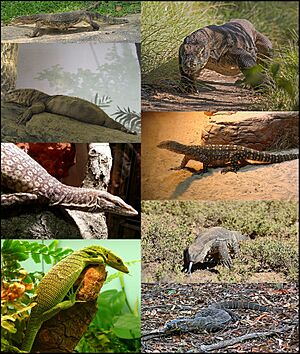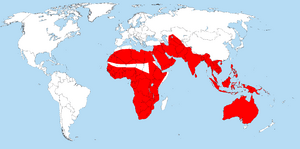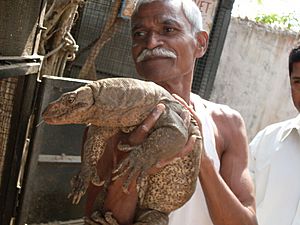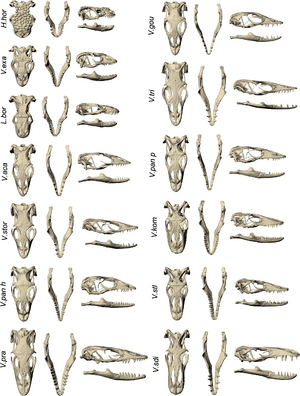Monitor lizard facts for kids
Quick facts for kids Monitor lizard |
|
|---|---|
 |
|
| Left: V. salvator, V. flavescens, V. tristis, V. prasinus Right: V. komodoensis, V. giganteus, V. albigularis, V. varius | |
| Scientific classification |
|
| Kingdom: | Animalia |
| Phylum: | Chordata |
| Class: | Reptilia |
| Order: | Squamata |
| Family: | Varanidae |
| Genus: | Varanus Merrem, 1820 |
| Type species | |
| Varanus varius Shaw, 1790
|
|
| Subgenera | |
|
|
 |
|
| Combined native range of all the monitor lizards | |
Monitor lizards are a special type of lizard found in many parts of the world. They belong to a group called Varanus. There are about 80 different kinds of monitor lizards. You can find them in Africa, Asia, and Oceania. One type has even spread to the Americas.
These lizards have long necks, strong tails, and sharp claws. Their legs are also very well-developed. Monitor lizards come in many sizes. Some are as small as 20 centimeters (8 inches) long. Others, like the Komodo dragon, can grow over 3 meters (10 feet) long! Long ago, an extinct monitor lizard called megalania might have been over 7 meters (23 feet) long. Most monitor lizards live on land. However, many can also climb trees or swim in water. Most monitor lizards eat meat. They hunt smaller reptiles, fish, birds, insects, and small mammals. They also eat eggs. But some species enjoy eating fruit and plants too.
Contents
What Are Monitor Lizards?
The name Varanus comes from an Arabic word, waral. This word means "lizard beast." In English, these lizards are called "monitors." The name might come from their habit of standing on their back legs. When they do this, they look like they are "monitoring" their surroundings. Another idea is that they were thought to "warn" people about dangerous animals.
In different parts of the world, monitor lizards have many local names. For example, in Southeast Asia, they are often called biawak or bayawak. In India, they have names like ghorpad or udumbu. In Australia, they are known as "goannas." This name came from a mix-up with another type of lizard called iguanas.
Where Do They Live?
Monitor lizards live in many places across the globe. You can find them in Africa and the Indian subcontinent. They also live in China, Japan, and Southeast Asia. This includes countries like Thailand, Malaysia, Indonesia, and the Philippines. They are also found in New Guinea, Australia, and islands in the Indian Ocean. Some, like the West African Nile monitor, have spread to new places. For example, they are now found in South Florida. Long ago, monitor lizards also lived in Europe.
What Do They Eat?
Most monitor lizards are carnivores. This means they eat only meat. Their diet includes insects, crabs, spiders, and snails. They also eat fish, frogs, other reptiles, birds, and mammals. Young monitor lizards often eat small invertebrates. As they grow bigger, they start hunting larger animals. For example, deer make up half the diet of adult Komodo dragons. However, some monitor lizards are different. Three species from the Philippines mostly eat fruit.
Amazing Biology
Monitor lizards are special because they look similar but come in many sizes. Their skulls and limbs can look different depending on where they live. Monitor lizards have large territories. They actively hunt their prey, much like some mammals do. They also have a very fast metabolism. This means their bodies use energy quickly. They have one of the highest metabolic rates among all living reptiles.
Like snakes, monitor lizards have a forked tongue. They use their tongue to "smell" their surroundings. The tongue picks up tiny molecules from the air. Then it carries them to special organs in their skull. Because the tongue is forked, they can sense where the smells are coming from. This helps them "smell in stereo."
Monitor lizards have a unique heart. Most reptiles have three-chambered hearts. But monitor lizards have a special wall in their heart. This wall helps separate the blood going to the lungs from the blood going to the body. This way, oxygen-rich blood gets to their body quickly. This helps them stay active and hunt.
Monitor lizards lay eggs. They usually lay between 7 and 38 eggs. They often hide their eggs in soil or inside hollow tree stumps. Some species, like the Komodo dragon, can even lay eggs without a male. This is called parthenogenesis.
Their Special Venom
Scientists believe that all monitor lizards might be venomous. Unlike snakes, their venom glands are in their lower jaw. Monitor lizard venom is very complex. It can affect their prey in different ways. For example, many species have venom that stops blood from clotting. This means that bites from these lizards can bleed a lot. The venom can also cause blood pressure to drop.
Some species, like the Komodo dragon and the desert monitor, have venom that affects the nervous system. For instance, the desert monitor's venom can cause paralysis in small animals. It can also have milder effects on humans.
Smart Lizards!
Monitor lizards are known to be quite smart. Some studies show that rock monitors can count up to six. Nile monitors have been seen working together to find food. One monitor might distract a female crocodile. While the crocodile is busy, the other monitor opens her nest to eat the eggs. Then the first monitor comes back to share the meal.
Komodo dragons at the National Zoo in Washington, D.C., can recognize their keepers. They also seem to have their own unique personalities. Blue and green tree monitors in zoos have been observed playing with leaves. They tear them up just for fun!
Monitor Lizards and Humans
Humans interact with monitor lizards in many ways.
As Pets

Many people keep monitor lizards as pets. The savannah monitor and Ackie dwarf monitor are popular choices. This is because they are smaller, less expensive, and can be calm if handled regularly. Other types, like the Asian water monitor and emerald tree monitor, are also kept as pets.
Traditional Uses
In some parts of South and Southeast Asia, monitor lizards are hunted. Their organs and fat are used in some traditional medicines. However, there is no scientific proof that these medicines work. In parts of India and Malaysia, people also eat monitor lizard meat, especially the tongue and liver.
Some people use parts of monitor lizards to treat pain, skin infections, and hemorrhoids. The oil from monitor lizards is also used as a lubricant. Eating raw blood or meat from monitor lizards can be risky. It can cause a brain infection because some monitors carry a parasite.
For Leather
Monitor lizard skins are used to make leather. This leather is very useful in the industry. In Papua New Guinea, monitor lizard leather is used for traditional drums called kundu. That's why these lizards are sometimes called "drum lizards." The leather is also used to make parts of musical instruments in India and Bangladesh.
For Food
Some tribes in India, Nepal, the Philippines, Australia, and Africa eat monitor lizard meat. It can be an extra source of food for them. In Southeast Asian countries like Vietnam and Thailand, both the meat and eggs are eaten as a special dish.
Protecting Monitor Lizards
Most monitor lizard species are not currently in danger of extinction. However, their numbers are decreasing worldwide. The Convention on International Trade in Endangered Species helps protect them. Most monitor lizards are listed under Appendix II. This means their trade is controlled to make sure they survive in the wild.
Five species are under stricter protection in Appendix I. This means international commercial trade of these species is against the law. These include the Bengal monitor, yellow monitor, desert monitor, clouded monitor, and the Komodo dragon. In many parts of India, it is illegal to catch or kill monitor lizards.
How They Evolved
Varanus is the only living group in the family Varanidae. The oldest known monitor lizard fossils are from Mongolia. They date back to the Late Cretaceous period. An ancient monitor lizard called Saniwa lived in North America. The oldest fossils of the Varanus group itself are from the early Miocene period. This suggests that monitor lizards first appeared in Asia.
Images for kids
-
Bengal monitor (V. bengalensis) with green iguana (Iguana iguana)
-
Blue-tailed monitor (V. doreanus)
-
Blue-spotted tree monitor (V. macraei)
-
Ridge-tailed monitor (V. acanthurus)
-
Crocodile monitor (V. salvadorii)
-
Water monitor (V. salvator)
-
Perentie (V. giganteus)
-
Komodo dragon (V. komodoensis)
-
Unknown species lizard in Raja Ampat Papua, 2016
-
Varanus jobiensis in Raja Ampat Papua, 2017
See also
 In Spanish: Varanus para niños
In Spanish: Varanus para niños




















